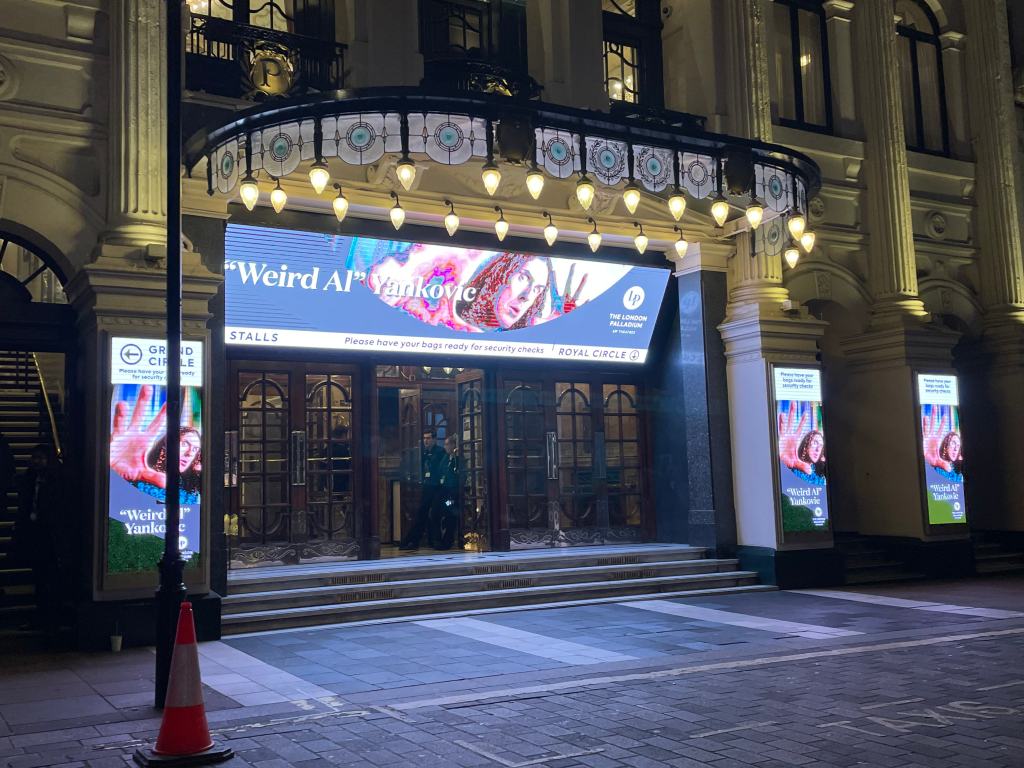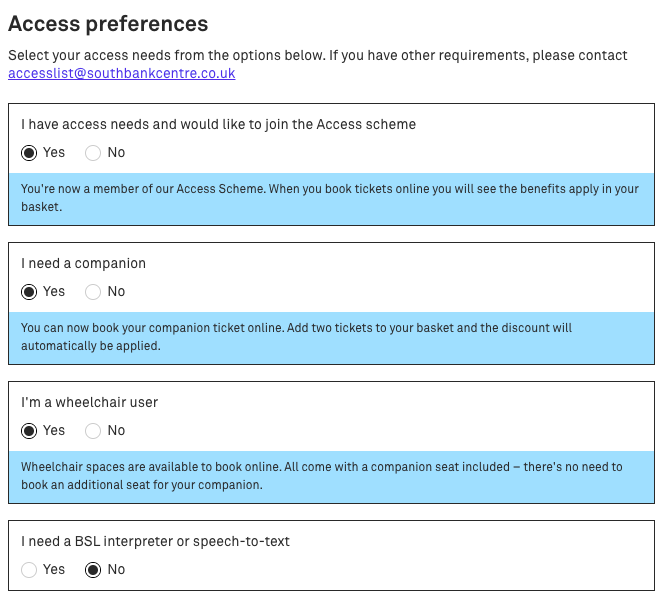
The London Palladium is one of the capital’s most celebrated theatres, having hosted shows and revues since 1910. It has just under 3,000 seats and a few wheelchair spaces. We visited earlier this week to see Weird Al Yankovic – I will not accept any shaming! – and I realised that this must be the first time I’ve actually been there since I was about 9 when my dad took me to see the celebrated revivial of Oliver! (which I now know starred Jonathan Pryce as Fagin – no wonder my dad wanted to see it!). I am familiar with Argyll Street, though, having spent many Friday evenings as a teenager rushing there as soon as I could after school to purchase tickets (in person! with cash!) from Stargreen’s box office for gigs in far less fancy venues. I have some surprising nostalgia for those years, when I didn’t worry about access issues and when £30 was considered a bit steep for a concert. When, as my erudite Welsh friend puts it, I’d throw myself into mosh pits full of 6ft+ metalheads “like f**kin Bambi on ice” despite being about as sturdy as a matchstick model held together with bubblegum. Considering it turns out that I do basically have bubblegum for connective tissue I’m amazed I never ended one of those nights in hospital, but I did come home with my fair share of giant bruises. Back then I could never have imagined going to a gig without standing/dancing/pummelling the hell out of a stranger then sharing a beer with them. I digress, but it’s amazing what I remembered as we turned into Argyll Street. Now back to our regularly scheduled review:
Getting Tickets
The Palladium is a member of the LW Theatre Group, whose access scheme allows members to book online and to book tickets over the phone without having to send proof of eligibility for wheelchair space or companion tickets every time. However, I chose to phone them for this event and there was no problem processing my order or adding the extra ticket.
Getting There
This is far easier than it used to be thanks to the fully accessible Elizabeth Line! Before it came along, if I wanted to go anywhere in the Soho, or Mayfair areas I would have to go to Green Park and go on the pavements through tourist hell from there. Taking the Elizabeth Line to Bond Street brought us out just a 3 minute roll from the theatre which was perfect.
Entrance
Next to the steps to the grand circle outside the theatre (so to the left of the image above) is a gently sloped passage where a member of staff took us through into the theatre. From there we were met by a dedicated access staff member who took us in a lift to the level of the bar and our booked space. The lift is quite small, but I was able to fit in with my midsized powerchair, my partner, and the staff member. The bar is accessible but doesn’t have a lowered area. The merchandise stand was also in this area. To get to the doors into the theatre itself there was a curving ramp integrated in next to the stairs where the access staff member was waiting for guests using wheelchairs and other mobility aids.
Wheelchair Space
The route to the wheelchair space itself and the distance between the spaces and the accessible toilet is the only negative I can find with the Palladium’s access but there is a good reason for it. We entered during the break after the support act, and the access staff took us across the back of the theatre, around a rather steep corner (it was a struggle to keep all wheels on the ground!), then down along the sides of the stalls seating. As you can imagine, this included quite a lot of “excuse me please” and “mind your feet!” because there wasn’t a lot of space for people to move out of the way. The spaces were right at the front on the ends of rows A and B, and occupied by myself and a young man in another powerchair. Because of the way the spaces were so close, if I’d needed to leave for any reasons he would have had to move out into the aisle too and it would have been quite… beepy. I can’t fault the Palladium, though. The access staff member told me that they used to have the wheelchair spaces at the back row of the stalls both to avoid the issues getting down the aisle and also to keep proximity to the accessible loo, but while this works well for the pantomime, it doesn’t work quite so well for concerts where audiences often stand up and dance/cheer and block all view for the people in the back who can’t stand up! (I remember this problem from Father John Misty at the Barbican, but luckily that was only during the last song!) We were also positioned right next to a speaker, which didn’t impede our view but did make it quite an overly loud experience in my right ear. I’m not sure if the sound system was set up specifically for that one show, though.
Services
It’s always appreciated when theatres have dedicated access staff, and it’s easy to tell when they are proper Dedicated Access Staff and not “the staff member who was put on wheelchair duty that day”. I can’t fault them at all. There was a queue for the loo afterwards and one of the staff was telling us how she was now a mental health first aider, and how she sometimes had to take overstimulated kids out of the seats to decompress, hand out ear defenders, or let off steam by dancing or stimming at the back of the theatre. It was lovely to hear that it’s not just physical disability that is treated well at the Palladium and we were very impressed with the staff there.
Toilets
There is one accessible loo at the Palladium, located through a door next to the entrance into the stalls. The vestibule which it is in also holds transport wheelchairs, walkers etc. belong to patrons who can transfer into theatre seats or collect their mobility aids after the show. The loo itself is an impressive size for a West End theatre – I was able to turn my wheelchair around to leave instead of reversing out by ramming the door – however there is no room for side transferring due to placement of bins. There is a large grab-handle on the door to close it, but the lock is a small turning one which might be a problem for someone with grip difficulties.
Overall I was pleasantly surprised and impressed. My experience of West End theatres since using a wheelchair has ranged from difficult to very difficult on the whole, and it’s great that the Palladium is bucking the trend. All the great staff in the world can’t make up for poor access, but the Palladium wins on both counts.
and now:








